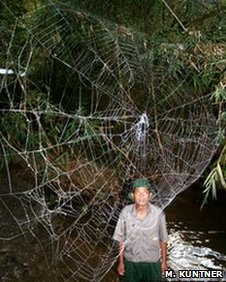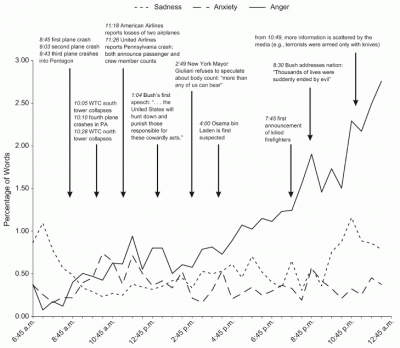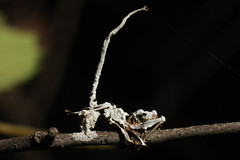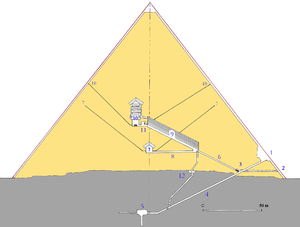Some of these books, not so surprising. But others? Oh yeah.
Seems that creativity and imagination are synonymous with "satanism".
And the banning of a dictionary, I mean really?

Some of these books, not so surprising. But others? Oh yeah.
Seems that creativity and imagination are synonymous with "satanism".
And the banning of a dictionary, I mean really?

Millions of killer giant squid are not only devouring vast amounts of fish they have even started attacking humans.
Two Mexican fishermen were recently dragged from their boats and chewed so badly that their bodies could not be identified even by their own families.
No wonder the giant squid are called "diablos rojos" - red devils.
You can read more here.

An ant mill is a phenomenon where a group of army ants separated from the main foraging party lose the pheromone track and begin to follow one another, forming a continuously rotating circle. The ants will eventually die of exhaustion. This has been reproduced in laboratories and the behaviour has also been produced in ant colony simulations. This phenomenon is a side effect of the self-organizing structure of ant colonies. Each ant follows the ant in front of it, and this will work until something goes wrong and an ant mill forms. An ant mill was first described by William Beebe who observed a mill 1,200 feet (365 m) in circumference. It took each ant 2.5 hours to make one revolution. Similar phenomena have been noted in processionary caterpillars and fish.Check out footage below:

 A newly-discovered species of spider, found in Madagascar, apparently spins the world's largest webs - they span more than 25 meters, or 82 feet (80 percent of the length of an average-sized blue whale!). From the BBC:
A newly-discovered species of spider, found in Madagascar, apparently spins the world's largest webs - they span more than 25 meters, or 82 feet (80 percent of the length of an average-sized blue whale!). From the BBC: The spider also makes the largest orb web yet found for any spider, and constructs it out of the most tough biomaterial yet known, say scientists.
Darwin's bark spider, a species new to science, weaves its huge web over flowing rivers, stretching from bank to bank.
It is so big that it can catch 30 or more prey insects at any one time.
Darwin's bark spider weaves what experts call an orb web, the most familiar spider web design
But this web is unusual as it is the largest orb web yet known to be made by any living spider, with the largest web measuring 2.8m².
You can read and see more here.

It turns out that bacteria carrying the NDM-1 gene have spread around the world. Meanwhile, home-grown superbugs with resistances of their own have been found in 35 different states. Even more troubling: they render ineffective even our "last ditch" treatments for other infections that won't respond to standard antibiotics. From USA Today:
"We've lost our drug of last resort," Fishman [director of infection control and epidemiology at the University of Pennsylvania and president of the Society of Healthcare Epidemiologists] says.Perhaps we shouldn't be surprised. Scientists, scholars, and other whistle-blowers have been warning us for some time that our overuse of antibiotics - particularly on factory farms, where drugs are dispensed en masse to healthy animals to prevent infections in unsanitary conditions - could give rise to something particularly nasty. Really, you could call this a classic tale of scientific overreaching - like Frankenstein's monster, our hubris is coming back to haunt us.
Doctors say the bacteria are more worrisome than another well-known superbug, methicillin-resistant Staphylococcus aureus (MRSA), because more drugs are available to treat MRSA, Fishman says. "When MRSA started to develop 15 years ago, the industry started producing antibiotics now coming onto the market," he says. "We're in the same position with KPCs as we were with staph aureus 15 years ago, except that the pharmaceutical industry isn't rushing to produce new drugs."

 gued? Read on:
gued? Read on: How does one achieve The Quietest Place on Earth? Start with a room within a room, within a room: the Orfield Labs six sided anechoic chamber is a small room floating in a pit on I-beams that are on top of springs. A five sided chamber of identical construction surrounds it on the edge of the pit. Both chambers are made of double wall steel-insulation-steel. The anechoic chamber was manufactured by Eckel, the largest anechoic chamber builder in the country.The room is, in fact, the Guinness World Record holder for the quietest place on Earth. You can read the original article here. But please remember, silence is golden.
Both steel chambers are held within a larger room that was built with solid one foot thick concrete walls and ceiling panels. The smaller room is filled with 3.3 feet thick fiberglass acoustic wedges. This approach led to the anechoic chamber found at Orfield Labs being measured by engineers on January 21st of 2004 at negative 9.4 dB (with A-weighting), thus earning it the title of Quietest Place on Earth. By comparison, the low threshold for human hearing is considered to be 0 dB.

If someone near you yawns, do you yawn, too? About half of adults yawn after someone else does in a phenomenon called contagious yawning. Now a new study has found that most children aren't susceptible to contagious yawning until they're about 4 years old -- and that children with autism are less likely to yawn contagiously than others.There seems to be something to this argument. Many animals yawn, but most don't yawn contagiously - those that do tend to be social mammals like chimpanzees.
"Given that contagious yawning may be a sign of empathy, this study suggests that empathy -- and the mimicry that may underlie it -- develops slowly over the first few years of life, and that children with ASD may miss subtle cues that tie them emotionally to others," according to the researchers. This study may provide guidance for approaches to working with children with ASD so that they focus more on such cues.


Image via Wikipedia
Paul K. Kuroda, a chemist from the University of Arkansas, calculated what it would take for a uraniumore body spontaneously to undergo selfsustained fission. Amazingly, the actual conditions that prevailed two billion years ago in what researchers eventually determined to be 16 separate areas within the Oklo and adjacent Okelobondo uranium mines were very close to what Kuroda outlined. These zones were all identified decades ago.You can read the full article here. It concludes, interestingly, that there may have been yet other naturally-occurring nuclear reactors in our planet's past. Go figure.


A family in Worcestershire were trapped inside their house for two hours after a scary, staring badger left them too frightened to leave.This sounds a bit silly, but I think it's understandable. Badgers are well known for their intimidating stares; this is related, in part, to the etymology of the term "badger" (as in, "to harass or urge persistently; pester; nag"). Note, of course, that common synonyms for "badger" include "vex," "bedevil," "plague," "worry," "disturb," and "bait," all words that this story brings to mind.
Dad Michael Youngs tried to scare the badger away by banging a spade on the ground, but it didn't move.Mr Youngs told a newspaper: "The badger was very spooky.
"It was the stare that really gave me the creeps," he added.


Image by jterning via Flickr
The Homeland Security Department plans to test futuristic iris scan technology that stores digital images of people's eyes in a database and is considered a quicker alternative to fingerprints.This could be interesting. As long as the technology isn't abused or overused, it certainly seems like it could have valid applications - but who knows how it'll actually turn out. I'm not looking forward to personalized holographic advertisements that track you by your irises, though.
Iris scanners are little used, but a new generation of cameras that capture images from 6 feet away instead of a few inches has sparked interest from government agencies and financial firms, said Patrick Grother, a National Institute of Standards and Technology computer scientist.

 which is more or less exactly what it sounds like: patrons dine on a platform suspended 50 meters (that's 164 feet, for those of you unfamiliar with the metric system) in the air. For comparison, that's almost equal to the height of the Leaning Tower of Pisa or Niagara Falls (.91 Pisas and .98 Niagaras, too be exact; also, incidentally, the exact length of an Olympic-sized swimming pool).
which is more or less exactly what it sounds like: patrons dine on a platform suspended 50 meters (that's 164 feet, for those of you unfamiliar with the metric system) in the air. For comparison, that's almost equal to the height of the Leaning Tower of Pisa or Niagara Falls (.91 Pisas and .98 Niagaras, too be exact; also, incidentally, the exact length of an Olympic-sized swimming pool). Dinner in the Sky is available for a session of 8 hours. It can be divided or personalised according to the client's wishes.
Dinner in the Sky accomodates 22 people around the table at every session with three staff in the middle (chef, waiter, entertainer...). Just to give you an example: this means that, at a rate of 2 sessions per hour, more than 350 people could have access to this exceptional platform, or only 22 if you want an exclusive VIP event.
Dinner in the Sky is an event that can be held anywhere (golf course, public place, race track, castle, vineyard, historical site...) as long as there is a surface of approximately 500 m² that can be secured. Of course, authorisation by the owner is required.
Of course, it's pricey - $289.00 per person in the United States. Other services offered include "Meeting in the Sky," "Showbiz in the Sky," and - my favorite - "Wedding in the Sky."



Once known as "horse hair" worms because they would appear mysteriously in horse troughs, Gordian worms spend their parasitic larval stage within the bodies of insects, especially crickets, but spend their non-parasitic adult stage in water. Crickets aren't known for their swimming ability, but try telling that to a parasitic nematode (really, try it. They don't even comprehend English, it's ridiculous.) When it's time for adulthood, the worm compels its cricket to seek out the nearest body of water and dive right in. The confused cricket usually drowns, while the worm wriggles free to find itself a mate.I think it's the Gordian worm's appearance that really does it for me. Check out this uncomfortably-creepy video of a worm emerging from a cricket:



Image by myriorama via Flickr
The fungus's spores enter the body of the insect through its respiratory spiracles, where they begin to consume the non-vital soft tissues. When the fungus is ready to spore, its mycelia enter the ant's brain and change how it perceives pheromones, causing the insect to climb up the stem of a plant and use its mandibles to secure itself to the plant. Infected ants bite the leaf veins with abnormal force, leaving telltale dumbbell-shaped marks.This creeps me out, to be honest. According to Harvard scientist David Hughes, "This can happen en masse. You can find whole graveyards with 20 or 30 ants in a square metre. Each time, they are on leaves that are a particular height off the ground and they have bitten into the main vein before dying."
You can read more here.The gruesome hallmark of the fungus's handiwork was found on the leaves of plants that grew in Messel, near Darmstadt in Germany, 48m years ago.
The finding shows that parasitic fungi evolved the ability to control the creatures they infect in the distant past, even before the rise of the Himalayas.


Image via Wikipedia
In the Queen's Chamber, there are two further shafts, discovered in 1872. Unlike those in the King's Chamber, these do not lead to the outer face of the pyramid.
No one knows what the shafts are for. In 1992, a camera sent up the shaft leading from the south wall of the Queen's Chamber discovered it was blocked after 60 metres by a limestone door with two copper handles. In 2002, a further expedition drilled through this door and revealed, 20 centimetres behind it, a second door.
Driven by morbid curiosity (and no doubt more than a little dread), researchers have designed remote-controlled robots to explore the shafts and drill through the doors:
Now technicians at Leeds University are putting the finishing touches to a robot which, they hope, will follow the shaft to its end. Known as the Djedi project, after the magician whom Khufu consulted when planning the pyramid, the robot will be able to drill through the second set of doors to see what lies beyond.
You can read more here. I shiver to think of what, if anything, may lie on the other side.

When British scientist Jason Chapman told us (listen to the radio piece or watch our video) there are 3 billion insects passing over your head in a summer month, he was talking about his survey in Great Britain. Closer to the equator, he says, the numbers should rise. He wouldn't be surprised, for example, that in the sky over Houston or New Orleans there could be 6 billion critters passing overhead in a month.Why are they up there? The article goes on:
Sometimes insects and spiders need to leave where they are and go someplace else for food, for sex, for space. For a variety of reasons bugs disperse.Bugs have been found over the Atlantic "at 2,460 to 5,410 feet and over Greenland at 7,870 to 12,135 feet"; the record-holder is a single termite that was captured at 19,000 feet.

Recent Comments
Alec Defosses :
:
Good read. I saved the page for future visit. read moreShakira Furci :
:
Incredibly interesting piece of content. I was in search of read moreRitts :
:
Your site is amazing. I wonder just how do you read moreMeda Kiner :
:
I found your blog in the "Trackback" section of another read moreGale Mady :
:
The integration of bears into a godly American holiday read moreB. Samuel :
:
This information on how earth worms behave is very fascinating. read more